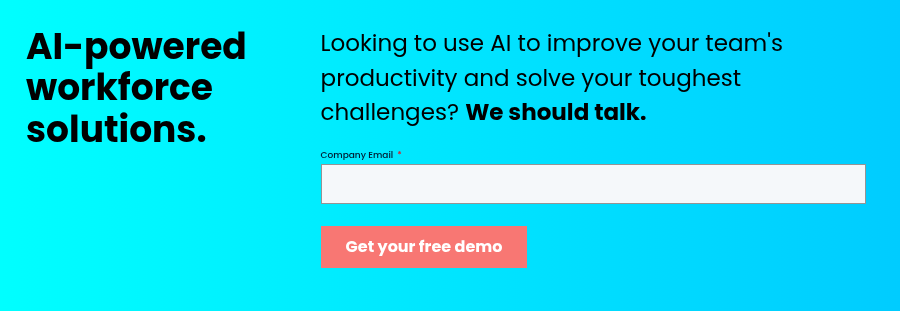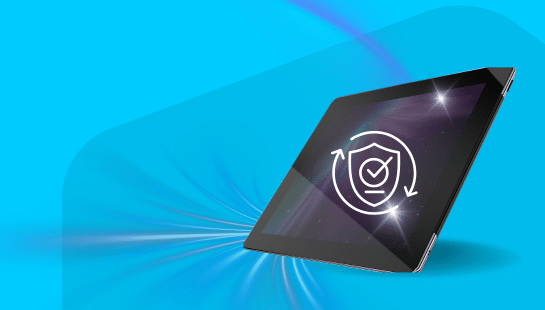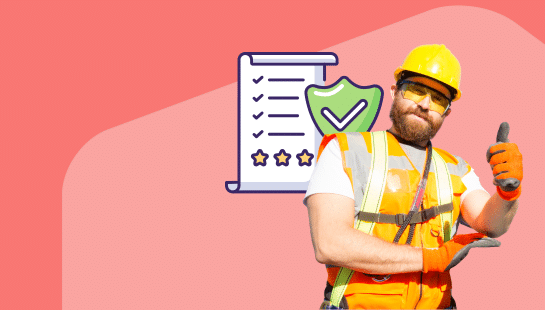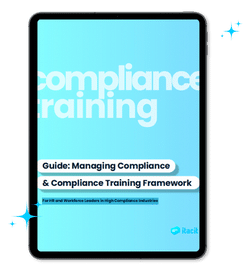AI in employee engagement has evolved from a niche technology into a mainstream tool. 88% of organizations globally now use AI in HR according to the Society for Human Resources Management. This rapid adoption emphasizes how AI has become crucial for workplace management and staff satisfaction.
Our 2024 Employee Experience Trends Report revealed an interesting pattern – employees prefer AI assistance over AI management. Some groups show greater openness to AI involvement in human-centered activities like performance appraisals and job interviews, particularly employees with disabilities and those who identify as transgender or non-binary. A notable comfort gap exists based on position and engagement levels. 65% of C-suite executives feel at ease with AI at work, while only 46% of managers share this comfort. The numbers also show 53% of engaged employees welcome AI, compared to just 30% of disengaged staff.
AI’s role in employee engagement goes way beyond simple automation. These tools now handle everything from onboarding to performance tracking. They can spot early signs of burnout through productivity patterns and offer 24/7 support via chatbots. AI systems customize learning programs based on career goals and skills gaps, streamline repetitive tasks, and recognize employee achievements immediately.
This piece looks at how AI drives and measures employee engagement. It explores benefits and ethical concerns while offering practical guidance to implement AI solutions that boost workforce satisfaction without compromising trust and transparency.
What is AI in Employee Engagement?
AI in employee engagement automates knowledge tasks that humans once handled exclusively. This technology analyzes complex data, communicates, solves problems, and learns patterns to boost how organizations connect with their workforce.
Understanding the role of AI in HR functions
AI in HR goes beyond fancy software. This powerful tool changes how companies and employees work together. Research reveals that 94% of business leaders see AI as vital to success. About 80% say AI helps their teams work better and make smarter decisions.
Companies have embraced AI in human resources faster than ever. The number of HR leaders testing and planning AI projects doubled between June 2023 and January 2024. Right now, 79% of UK leaders use at least three different AI applications.
AI makes the biggest difference in these areas:
- Talent acquisition (64% of organizations using AI for HR)
- Learning and development (43%)
- Performance management (25%)
To name just one example, AI now powers recruitment by screening applications and writing job descriptions. It finds the right candidates faster than traditional methods. The technology creates custom training plans based on each employee’s skill gaps. AI also changes performance reviews by analyzing employee data for better company-wide assessments.
How AI simulates human decision-making
AI mirrors human intelligence through machine learning and natural language processing. These systems learn from employee data, feedback, and performance metrics to create applicable information.
“Think of it as the automation of knowledge tasks,” says Dr. Benjamin Granger, Head of EX Advisory Services at Qualtrics. AI excels at evidence-based decisions like analyzing work patterns or finding skill gaps.
The main difference lies in context. Human decisions often involve social and emotional elements. This explains why employees prefer AI for certain tasks over others. While 61% welcome AI help with writing, only 29% want it during job interviews.
AI still needs to develop emotional intelligence. One expert puts it simply: “AI isn’t replacing humans, it’s strengthening them. It’s the ultimate teammate, freeing up employees to focus on what they do best”.
Why AI is becoming central to engagement strategies
AI now forms the foundation of modern engagement strategies. The business effects speak volumes, 99% of decision-makers say AI investments benefit their business. About 42% of business owners believe AI will improve job processes.
AI spots disengagement early through predictive analytics. Organizations can take action before performance suffers by watching for signs like lower productivity or negative feedback.
On top of that, it personalizes experiences at scale. Old one-size-fits-all approaches often miss the mark. AI creates custom experiences, from learning paths to recognition programs that match individual needs.
This move toward AI reflects new employee expectations. Deloitte’s research shows 32% of UK respondents already use Generative AI at work. People now want the same quick responses and personal touch at work that they get as consumers.
Fears about job losses have given way to partnership opportunities. Only 30% of organizations strongly prefer full automation. By 2036, AI solutions will create over half a billion new human jobs.
The iTacit AI HR Assistant shows this trend perfectly. It helps teams communicate better while keeping humans in charge of decisions. This mix of automation and human expertise works best, AI handles routine tasks while people focus on creative, strategic work that machines can’t copy.
Benefits of Using AI to Drive Engagement
Companies that use AI in employee engagement see amazing returns on investment. A study shows organizations using AI saw their employee engagement go up by 31%. These results come from three main advantages AI brings to the workplace.
Faster decision-making with data
The days of manual survey compilation are over. AI turns raw data into practical insights almost right away. This lets HR professionals make better informed decisions faster.
AI learns from feedback through machine learning algorithms and adapts to give more accurate insights. To cite an instance, see IBM’s Watson that uses natural language processing. It understands what employees feel and suggests solutions before problems grow.
Numbers tell the story clearly. Companies that use HR analytics see a 15-20% boost in productivity. Teams using AI for performance management cut their review time by 20%.
AI spots patterns in engagement surveys and shows exactly where attention is needed. HR teams can now take action before problems hurt morale or performance.
McKinsey research shows that AI helps organizations test decisions before making them. Digital twins help simulate situations and test assumptions. HR can now predict skill needs 5-10 years ahead, which keeps companies ready for future workforce needs.

Improved personalization of employee experiences
The biggest advantage of AI for employee engagement lies in creating tailored experiences at scale. AI analyzes each employee’s data to create personal development plans that fit their skills, interests and career goals.
Results speak for themselves. Companies with tailored training programs saw 30% higher engagement. Zoom tried AI-created personal learning plans and employee satisfaction jumped 32%.
Platforms like iTacit, LinkedIn Learning and Degreed use machine learning to suggest courses based on skills, career goals, and past learning. These tools adapt to how each person learns best, which helps them retain knowledge and develop skills.
AI personalizes many parts of an employee’s work life:
- Career paths with AI-suggested internal moves
- Ongoing performance feedback instead of yearly reviews
- Recognition programs that activate at meaningful moments
- Wellness support based on personal stress signs and work patterns
Increased productivity and reduced admin load
AI takes care of admin tasks that used to eat up HR professionals’ time. The core team can now focus on strategy and meaningful human connections.
The numbers add up – organizations using AI tools saw 15% better operations and 20% more productivity. Workers who know how to use AI properly performed 40% better than those who didn’t.
Tools like UiPath and Automation Anywhere handle repeated tasks like data entry, scheduling, and compliance reports. Virtual assistants in Microsoft Teams can create meeting summaries, suggest agenda items, and write emails based on context.
IBM’s Watson Assistant and iTacit’s AI HR Assistant show how AI provides constant support. They answer common questions about policies, benefits, and procedures without human help. Employees get answers right away, whatever their time zone or HR office hours.
AI scheduling tools also balance shifts based on worker priorities and workloads, which leads to fewer conflicts and better productivity. This helps organizations that have complex staffing needs.
The end result? HR professionals now predict instead of react, influence instead of report, and focus on strategy instead of paperwork.
Risks and Ethical Concerns of AI in Engagement
AI in employee engagement brings many benefits, but companies worry about how to use it properly. A closer look at these risks shows why many organizations hold back from fully accepting these technologies.
Data privacy and security issues
Companies adopting AI employee engagement tools place privacy at the top of their concerns. Data breaches in organizations can cost approximately USD 3.15 million. Security has become both an ethical and financial necessity.
Employees now create massive amounts of data in our digital world, about 463 exabytes daily compared to just 3 exabytes in 2015. This huge increase magnifies the risk that sensitive employee information might fall into wrong hands.
Money isn’t the only thing at stake. Organizations that don’t protect data properly might face:
- Compensatory penalties and fines
- Legal actions
- Major damage to their reputation
“Digital privacy is crucial to maintain trust,” notes one industry expert. “Without this trust, companies are destined to burn bridges with both consumers and employees, risking business reputation and overall success”.
Collecting and storing employee data always comes with risks. Companies must protect employee privacy rights and follow data protection rules. Simple compliance helps, but ethical organizations do more by using advanced security measures like encryption to protect against unauthorized access.
Bias in AI algorithms
AI systems for employee engagement face their biggest ethical challenge in algorithmic bias. Machines learn and magnify hidden prejudices from the data they process.
Amazon learned this lesson when their AI-driven hiring model showed clear preference for male candidates in technical roles. Past gender imbalances in the company and tech sector created this bias.
Bias usually comes from:
- Limited or unrepresentative training data
- Biased algorithm designers
- Historical patterns of discrimination
These biases show up in worrying ways. Research proves AI systems can discriminate based on gender, race, color, and even personality traits. Some algorithms check word choice, tone shifts, and facial expressions to determine a candidate’s “personality” and cultural fit, methods that can easily lead to discrimination.
A survey found that 65% of people believed AI-based tools would be used fairly. All the same, evidence suggests we should be careful. AI systems working with biased data keep producing unfair results, and experts call this “agentic discrimination” when it affects protected groups.
Lack of transparency and employee trust
Trust suffers when AI becomes a “black box” in employee engagement. Most AI systems don’t explain how they make decisions.
Yes, it is a legal risk too. One expert points out, “In a world where transparency is paramount, the opacity of AI decision-making processes could potentially become a legal quagmire”. Employment tribunals might question hiring decisions that lack clear explanations.
Building trust needs clarity about:
- Data sources and usage
- Decision-making processes
- Ongoing monitoring and auditing
The World Economic Forum found only 55% of employees believe their organization will use AI responsibly. It also shows 42% think their company doesn’t know which systems should be fully automated versus those needing human input.
Some surveys hint that employees trust AI more than potentially biased managers. Organizations still need to close the AI trust gap. Employee trust and accountability suffer without clear communication about decisions and proof of fairness.
iTacit’s AI HR Assistant shows how to keep things transparent, it helps improve internal communication while keeping humans central to decisions, striking a balance between automation and human interaction.
How AI Measures Employee Engagement
Companies no longer rely on yearly surveys to measure employee satisfaction. AI in employee engagement makes use of information from multiple data points to monitor workforce sentiment continuously. This provides insights that weren’t possible before.
Sentiment analysis from surveys and feedback
Modern AI tools analyze employee feedback from various sources through natural language processing to understand emotions and attitudes. These systems look at:
- Survey responses and open-ended comments
- Internal communication channels and emails
- Social media posts and job review sites
- Team chat platforms like Slack or Microsoft Teams
Research shows 70% of employees feel more motivated with regular feedback. AI sentiment analysis has become a great way to get insights. The system doesn’t just count positive or negative words, it understands context, tone, and even sarcasm to give a clear picture of employee feelings.
“Traditional surveys prioritize accelerated data gathering through concise, multiple-choice questions, inadvertently overlooking nuance and deeper opinions,” notes one expert. AI-powered solutions capture subtle meanings in open-text comments and uncover hidden feelings that many employees share.
This technology connects responses to key areas like leadership, professional growth, diversity, and work-life balance. These factors substantially affect employee motivation and commitment over time.
Predictive analytics to detect disengagement
AI employee engagement tools excel at identifying employees at risk of leaving before they quit. AI detects subtle signs of disengagement that managers might overlook by analyzing past patterns.
Companies now track declining productivity, absenteeism, and negative feedback to spot potential flight risks. AI tools watch an employee’s meeting participation, task completion rates, and peer feedback to spot concerning behavior changes.
Disengagement costs the global economy $8.90 trillion in lost GDP. HR teams can address issues early through predictive modeling and target specific individuals or teams who need help.
“Understanding what makes employees disengage helps target solutions effectively,” an industry analyst explains. “A detailed analysis reveals patterns of systemic issues, not just isolated incidents.”

Real-time performance tracking
The role of AI in employee engagement has reshaped performance management. Annual reviews have given way to ongoing assessment. AI systems give immediate feedback during projects, which allows quick adjustments and recognition.
These systems monitor key standards like project completion, productivity metrics, and how people work together. Managers get notifications when employees hit milestones. The system also flags when someone needs help with tasks, allowing timely intervention.
Research shows companies using AI-driven performance solutions see up to 25% higher employee productivity. Those using AI for performance evaluation report 30% better employee satisfaction.
The iTacit AI HR Assistant helps managers keep up with trends by spotting early signs of stress, disengagement, or burnout. This approach supports employees quickly instead of waiting for problems to grow.
AI for employee engagement shines by offering continuous insights without survey fatigue. A performance management expert notes, “When employees know how they’re performing, they can adjust their development and focus to benefit both the company and their career”.
AI Tools That Support Engagement
The tech market offers many AI-powered tools that help companies boost staff engagement. These tools use advanced algorithms to create tailored, responsive, and effective work environments. Here’s a look at the main categories that reshape today’s HR scene.
Chatbots and virtual assistants
HR chatbots handle everyday staff questions with great speed. These AI-powered virtual assistants use natural language processing to understand what employees ask and provide answers or complete tasks without human help.
“Think of them as friendly, self-service HR representatives available 24/7,” notes one industry expert. These tools handle everything from benefits questions to policy clarifications. They create a consistent experience for employees whatever their time zone or work hours.
The worldwide adoption rate for AI in human resource management is 21%. Companies that use these systems see several benefits:
- Round-the-clock access to address concerns quickly
- Reliable and accurate information delivery
- Support in multiple languages with accessibility options
- Information gathering to keep improving
Chatbots help staff engagement by offering easy ways for staff and management to communicate. They run surveys, collect feedback, and give real-time support for HR questions.
AI-powered HR co-pilots
HR co-pilots show the next step in AI help. They go beyond basic chatbots to offer smart guidance in familiar work settings. These tools help HR professionals make better choices and finish complex tasks faster.
Salesforce’s Einstein copilot, which launched in February, helps staff schedule meetings, sum up documents, and answer general questions. Through its link with Basecamp, Einstein has handled over 88,000 queries. The average solution time dropped from two days to just 30 minutes.
“The biggest change here is you’re bringing all these separate systems together and making information available to everyone,” explains Salesforce CPO Nathalie Scardino. “You don’t have to check six or seven different systems to find your healthcare benefits”.
Microsoft’s Copilot for HR also helps solve staff issues, track organizational health, and run award programs.
Performance management systems
AI has changed performance management from a yearly task into an ongoing growth opportunity. These systems gather and study performance data from many sources to give more detailed evaluations.
AI’s ability to sum up both formal and informal employee performance data stands out as one of its best uses. The technology gathers information all the time, not just at set times during the year. This helps avoid issues like recency bias.
“GenAI can search your internal data and create good performance summaries for managers to review,” explains Kenneth Matos, global director of people science for Culture Amp.
Managers save lots of time as these tools turn simple bullet points into detailed performance reviews. They spend less time writing and more time having meaningful talks with staff.
AI-powered performance systems can:
- Design tailored learning plans based on review results
- Help staff prepare for reviews by organizing their achievements
- Create custom goals and action plans
- Study communication patterns to improve inclusion
Voice of the employee platforms
Voice of the employee (VoE) platforms collect and analyze staff opinions, views, and feelings. They provide insights with practical guidance to improve engagement, experience, and output.
Workday Peakon Employee Voice shows what these platforms can do with its new AI features. The platform uses generative AI to create content summaries that spot key themes from huge amounts of staff feedback in over 60 languages. Companies can address issues like workload or burnout before they become problems.
These platforms study patterns in staff behavior to predict things like possible turnover or promotion candidates. Tools like Macorva’s Voice of Employee platform use advanced AI models to process staff feedback and offer ways to improve management practices.
“In today’s tough business world, staying close to our employees leads to success, and Workday Peakon Employee Voice gives us quick feedback on what we can improve,” notes Anton Ketelaars of BDR Thermea Group.
The iTacit AI HR Assistant follows this approach. It helps managers improve internal communication while keeping humans central to decisions – striking the right balance between automation and the human touch needed for real engagement.
Real-World Examples of AI in Action
AI-powered employee engagement solutions have delivered impressive results for many organizations. These ground applications show how AI technologies benefit companies of all sizes.
iTacit’s AI HR Assistant for internal communication
iTacit’s AI Assistant shows how AI optimizes workplace communication by giving employees quick access to company policies and training materials. Staff members can type questions and get instant answers based on their roles.
The solution’s impact speaks for itself. 87% of users found the AI Digital Assistant helped answer questions more easily than before. Management teams saved 4.5 hours weekly on employee questions.
iTacit’s assistant uses only an organization’s verified knowledge base, unlike general-purpose AI tools. This approach ensures security and accuracy. Healthcare and manufacturing companies find this particularly valuable due to their compliance requirements.
Best Practices for Ethical AI Use in HR
AI in employee engagement requires an ethical and well-planned approach with clear guidelines. Organizations can build responsible AI frameworks that maximize benefits and build trust by following industry best practices.
Ensure transparency in data usage
Transparency serves as the foundation of ethical AI implementation. Data shows 85% of employees report having “AI-related considerations when joining a new company,” and nearly 60% list transparency about AI use as their biggest concern.
“In my experience as a VP at an AI company, remaining transparent with candidates has been vital to our success,” states John Pennypacker. “We prioritize informing applicants about our AI usage at the earliest stages”. This transparency should continue throughout employment.
Companies should focus on these aspects:
- Clear communication about AI usage and purpose
- Simple explanations without technical jargon
- Full disclosure of collected and analyzed data
- Clear information about AI’s influence on decisions
The evidence shows that “if you do AI properly at your organization (by being transparent, explaining everything and communicating the actions you’re taking as a result of it) employees will see the positive differences”.
Involve employees in AI implementation
Staff participation in AI development creates buy-in and helps spot potential issues early. Michael D. Brown points out, “Involve team members in establishing these guidelines to promote a sense of shared responsibility”.
Teams can host information sessions where staff ask questions and share concerns. This shared atmosphere helps bridge the trust gap. The World Economic Forum reports only 55% of employees trust their organization to implement AI responsibly.
iTacit’s AI HR Assistant demonstrates this approach by keeping humans central to decision-making while streamlining internal communication.
Monitor and audit AI systems regularly
Ethical AI demands consistent audits and monitoring. “Conduct regular audits of your AI systems. Are they functioning as intended and remaining compliant with legal and ethical standards?” suggests one Google HR leader.
These audits should examine:
- Algorithm and outcome bias
- Regulatory compliance (like GDPR and the EU AI Act)
- System performance and accuracy
- Data quality and integrity
The EU AI Act requires six key elements including “continuous testing, monitoring and auditing processes” and “logging data from oversight activities”. Organizations that implement these practices meet compliance requirements and build trust effectively.
A transparent and thoughtful approach to AI for employee engagement builds systems that support rather than distance your workforce.
Future Outlook: AI’s Evolving Role in Engagement
The digital world of AI in employee engagement continues to evolve at a faster pace toward sophisticated applications. Future trends show a remarkable development. Technologies once considered replacement tools now serve as partners that strengthen employees.
From automation to increased capability
The next generation of AI employee engagement tools will do more than automate tasks. These tools will magnify what humans can accomplish. A new understanding emerges as AI moves away from replacing human work to making employees better at their jobs.
“Think of AI as your co-pilot rather than your replacement,” explains one industry expert. This change shows how human-AI collaboration creates the most value.
The numbers paint a clear picture. AI will create 97 million new jobs globally by 2025. Additionally, 60% of workers say AI helps them complete tasks more efficiently.

AI as a partner in employee well-being
Mental health stands as a workplace priority, and AI has become a valuable ally. Future systems will spot subtle signs of burnout by analyzing communication patterns and work habits. This allows for early support measures.
Some key applications we’ll soon see:
- Sleep and activity tracking combined with work performance data
- Stress pattern detection through voice analysis in meetings
- Customized mental health resource recommendations
- Workload balancing suggestions based on capacity signals
The rise of AI-driven personalization at scale
The most significant change relates to personalization. AI will soon enable customized employee experiences without needing large HR teams.
Today, only big organizations can afford deep personalization. Tomorrow’s AI will make this capability available to companies of all sizes, offering tailored experiences in:
- Career development pathways
- Learning opportunities
- Communication priorities
- Recognition approaches
As one HR leader notes: “The days of one-size-fits-all are ending. Tomorrow’s workplace will feel like it was built specifically for you – because in many ways, it was.”
Conclusion
AI has dramatically changed how organizations approach employee engagement. In this piece, we’ve seen how AI tools analyze sentiment, predict disengagement, and create tailored experiences at scale. These capabilities deliver impressive results – from 31% higher engagement to 20% boosted productivity.
The most successful implementations share a common thread. They don’t replace human connection; they boost it. AI handles the data-heavy work while managers focus on meaningful conversations and relationship building.
Ethical considerations must guide any AI implementation. Organizations build trust rather than suspicion when they practice transparency about data usage, involve employees in the process, and audit their systems regularly. Without this foundation, even the most sophisticated AI tools will fall short.
AI continues to evolve from simple automation to true innovation, and the future looks promising. Small businesses will soon access tailored engagement solutions that were previously available only to large enterprises. This democratization will level the playing field in industries of all types.
AI works best as a partner, not a replacement. Tools like iTacit’s AI virtual assistant for HR represent this partnership approach – they streamline communication and provide instant answers while keeping humans central to decision-making.
Your AI implementation experience needs thoughtful planning and clear communication. Start small, measure results, and expand gradually. Some employees might hesitate at first, but showing how AI saves time and reduces frustration often turns skeptics into supporters.
Successful organizations will neither avoid AI nor surrender to it completely. They’ll find the sweet spot where technology and humanity complement each other. The goal isn’t simply to adopt new technology, but to create workplaces where people feel valued, understood, and strengthened to do their best work.










